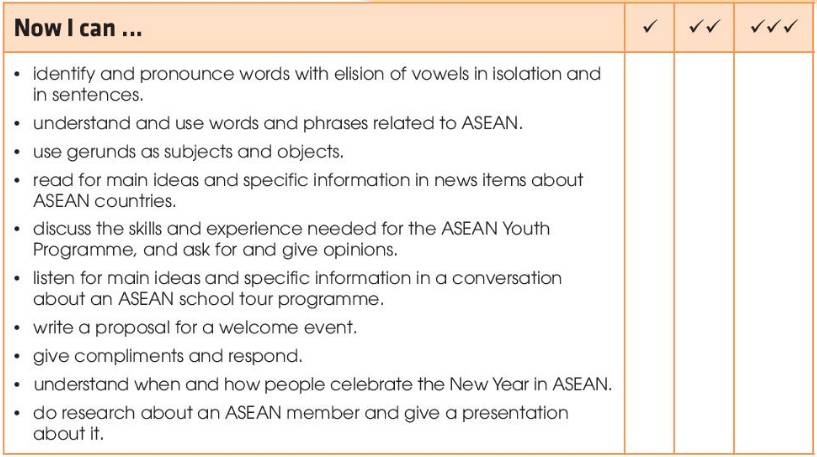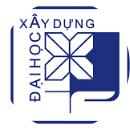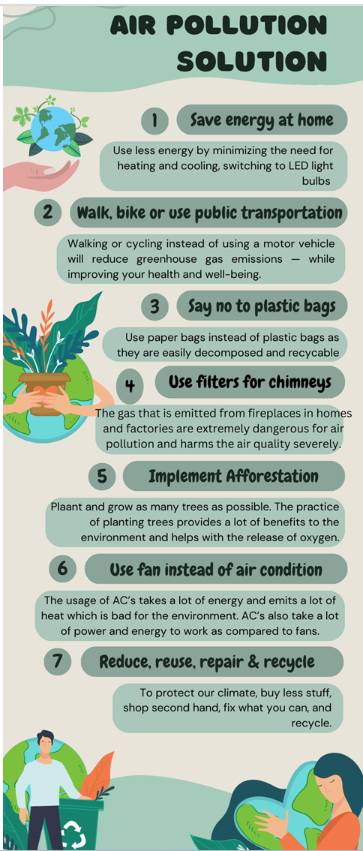Make a poster of your experience with pictures or photos.

Những câu hỏi liên quan
Make a presentation to show the results of your survey. Use technology or make a poster. Use pictures. Write sentences. Then upload your work to your teacher.
Here are some examples showing how you could present the results.
think about an appliance you would like to have in the future. make a poster for your future appliance . write details about the appliance on the poster . share your poster with the class
tự nhiên hỏi câu chắc có liên quan
Đúng 0
Bình luận (0)
Nghĩ về một thiết bị mà em muôn có trong tương lai. Làm một áp phích cho thiết bị tương lai. Viết những chi tiết về thiết bị trên áp phích. Chia sẻ áp phích của em với lớp.
- Hi-tech fridge: keep food cool and cook your meal (giữ lạnh thức ăn và nấu ăn cho bạn)
- Robot: clean house, take care children, feed dogs and cats (lau nhà, chăm sóc trẻ em, cho chó và mèo ăn)
Đúng 0
Bình luận (0)
Xem thêm câu trả lời
9. Work in groups. Plan a holiday for your class. Use photos, pictures or objects to make it more interesting.
(Làm việc nhóm. Lên kế hoạch cho một kỳ nghỉ cho lớp bạn. Sử dụng tranh ảnh hoặc đồ vật để làm cho nó thú vị hơn)
My class is planning a trip to Thailand.
(Lớp mình đang lên kế hoạch cho chuyến du lịch Thái Lan.)
Accomodation in Thailand: hostel because it is cheaper than hotel.
(Chỗ ở ở Thái Lan: nhà nghỉ vì rẻ hơn khách sạn.)
The tourist attractions: Siam square, The Grand Palce, National Museum & Wang Na Palce and Chatuchak market.
(Các điểm du lịch: Quảng trường Siam, The Grand Palce, Bảo tàng Quốc gia & Cung điện Wang Na và chợ Chatuchak.)
Places to eat: Thai restaurant, food street.
(Địa điểm ăn uống: nhà hàng Thái, phố ẩm thực.)
The best way to travel around: Tuk-tuk.
(Cách tốt nhất để đi du lịch xung quanh: xe tuk-tuk.)
Đúng 0
Bình luận (0)
THE COLOURS OF ASEAN (Sắc màu ASEAN)Work in groups. Find information about a member country of ASEAN. Present your research to the class. You can make a poster, a video, or presentation slides.Think about the following points:- General information (name, capital, currency, national flag, national animal/flower)- Geography (area, location)- Holidays (e.g. Independence Day. National Holiday)- People (population, culture, language(s) spoken, religions)
Đọc tiếp
THE COLOURS OF ASEAN (Sắc màu ASEAN)
Work in groups. Find information about a member country of ASEAN. Present your research to the class. You can make a poster, a video, or presentation slides.
Think about the following points:
- General information (name, capital, currency, national flag, national animal/flower)
- Geography (area, location)
- Holidays (e.g. Independence Day. National Holiday)
- People (population, culture, language(s) spoken, religions)

Located in Southeast Asia, Vietnam is a small and beautiful country with victorious history, profound patriotism and wonderful landscapes.
The Socialist Republic of Vietnam, widely known as Vietnam, is not a strange name to the whole world. Although this country is ravaged by a series of wars which cause serious damages, Vietnam in the eyes of the world is nice and peaceful. Vietnam is located in the eastern Indochina Peninsula in Southeast Asia, with Hanoi as its capital. With an area of 331,690 sq. kilometers, to the north of Vietnam is China, to the west is Laos and Cambodia, to the east is Gulf of Tonkin and East Sea, and to the south is Thailand Gulf. The land is a center of trading, cultural interaction, and even conflicts for centuries. It proves that Vietnam has an advantageous position in the region with long coastline and numerous attractions. Having a tropical climate, Vietnam is well known for from magnificent scenery and colorful hill tribes to wide terraced fields in Red River Delta and Mekong River Delta, to majestic mountains, and white sandy beaches. Vietnam, nowadays, is one of should-not-miss destinations in Asia.
Đúng 0
Bình luận (0)
Work in groups.
1. Choose a serious pollution problem in your area (noise pollution, air pollution, water pollution, ...). Suggest solutions to the problem.
2. Make a poster. Write your solutions on your poster. Use picture or illustrate / decorate your poster.
3. Present your poster to the class.

Exercise 1:
Air pollution is measured by a number called the Air Quality Index (AQI), which ranges from 0-500, with anything over 150 considered “unhealthy.” The World Health Organization considers any reading above 100 to be hazardous and recommends that people avoid prolonged exposure. While Vietnamese cities such as Hanoi and Ho Chi Minh City have AHI readings around 100 or higher, many provinces have far worse levels of pollution. In some areas of the south, where there are large rubber plantations and coal mines, AQI numbers can surpass 500.
(Ô nhiễm không khí được đo bởi một con số gọi là Chỉ số Chất lượng Không khí (AQI), có khoảng từ 0 đến 500, với bất cứ cái gì ở trên mức 150 sẽ được coi là “độc hại”. Tổ chức Y tế thế giới WHO cho rằng với mỗi lần đọc mà chỉ số trên 100 thì nghĩa là ở mức nguy hiểm và khuyến cáo mọi người tránh tiếp xúc lâu ở bên ngoài. Trong khi những thành phố ở Việt Nam như Hà Nội và thành phố Hồ Chí Minh đọc được chỉ số AHI khoảng 100 hoặc hơn, nhiều tính khác có mức độ ô nhiễm tệ hơn rất nhiều. Ở một vài vùng ở miền Nam, những vùng trồng cao su và mỏ than thì chỉ số AQI có thể vượt qua 500.)
Some simple way to reduce air pollution
(Vài cách đơn giản để giảm thiểu ô nhiễm không khí)
1. Using public transports
(Sử dụng phương tiện công cộng)
2. Turn off the lights when not in use
(Tắt điện khi không sử dụng)
3. Recycle and reuse
(Tái sử dụng và tái chế)
4. Say no to plastic bags
(Nói không với túi nhựa)
5. Reduction of forest fires and smoking
(Giảm thiểu cháy rừng và hút thuốc)
6. Use of fans instead of air conditioner
(Sử dụng quạt thay vì điều hòa)
7. Use filters for chimneys
(Sử dụng tấm lọc cho ống khói)
8. Avoid usage of crackers
(Tránh sử dụng pháo ống)
9. Avoid using of products with chemicals
(Tránh sử dụng các sản phẩm chứa nhiều chất hóa học)
10. Implement afforestation
(Tiến hành trồng rừng)
Đúng 0
Bình luận (0)
Exercise 3:
As we can know, air pollution is measured by a number called the Air Quality Index (AQI), which ranges from 0-500, with anything over 150 considered “unhealthy.” The World Health Organization considers any reading above 100 to be hazardous and recommends that people avoid prolonged exposure. While Vietnamese cities such as Hanoi and Ho Chi Minh City have AHI readings around 100 or higher, many provinces have far worse levels of pollution. In some areas of the south, where there are large rubber plantations and coal mines, AQI numbers can surpass 500. So, what can we do to improve our air quality? Here are some simple way to reduce air pollution.
The first one is saving energy at home. You can save energy by reducing the need for heating and cooling in your house and replace normal light bulb to energy saving fluorescent lights to help the environment.
The second one is using public transport or walking or riding bike whenever you can. Doing that will not only reduce the carbon emission but also help saving money. Also, walking or riding bike is good for your health.
Next is saying no to plastic bags. The use of plastic products could be very harmful to the environment as they take a very long time to decompose, due to their material made up of oil. The use of paper bags instead is a better alternative as they decompose easily and are recyclable.
Implementing afforestation is also a way to lessen air pollution. There are a lot of volunteer group plating forests every year but we can practice it at our home by plant a tree or make a garden in the yard. Trees helps release oxygen and make the atmosphere cooler.
The next one is use fan instead of air conditioner. The usage of AC’s takes a lot of energy and emits a lot of heat which is bad for the environment. AC’s also take a lot of power and energy to work as compared to fans.
Finally, we reduce, reuse, repair and recycle. We should buy less stuff and buy second hand, fix what you can and recycle. This helps save a lot of money and protect the environment.
Tạm dịch:
Như chúng ta đã biết, ô nhiễm không khí được đo bởi một con số gọi là Chỉ số Chất lượng Không khí (AQI), có khoảng từ 0 đến 500, với bất cứ cái gì ở trên mức 150 sẽ được coi là “độc hại”. Tổ chức Y tế thế giới WHO cho rằng với mỗi lần đọc mà chỉ số trên 100 thì nghĩa là ở mức nguy hiểm và khuyến cáo mọi người tránh tiếp xúc lâu ở bên ngoài.
Trong khi những thành phố ở Việt Nam như Hà Nội và thành phố Hồ Chí Minh đọc được chỉ số AHI khoảng 100 hoặc hơn, nhiều tính khác có mức độ ô nhiễm tệ hơn rất nhiều. Ở một vài vùng ở miền Nam, những vùng trồng cao su và mỏ than thì chỉ số AQI có thể vượt qua 500. Đây là vài cách đơn giản để giảm thiểu ô nhiễm không khí.
Đầu tiên là tiết kiệm điện ở nhà. Bạn có thể tiết kiệm năng lượng bằng cách giảm nhu cầu sưởi ấm và làm mát trong nhà và thay bóng đèn thường thành đèn huỳnh quang tiết kiệm năng lượng để bảo vệ môi trường. Thứ hai là đi phương tiện công cộng hoặc đi bộ hay đạp xe bất cứ khi nào có thể. Thực hiện việc đó có thể làm giảm khí thải cacbon mà còn tiết kiệm tiền. Đi bộ và đạp xe cũng giúp cải thiện sức khỏe. Thứ ba là nói không với túi ni-lông. Việc sử dụng túi ni lông rất có hại cho môi trường vì chúng rất khó phân hủy, do nhựa được làm từ dầu mỏ. Sử dụng túi giấy là một biện pháp thay thế tốt vì dễ phân hủy và có thể tái chế. Trồng rừng cũng là một cách để giảm ô nhiễm không khí. Hằng năm có rất nhiều nhóm tình nguyên tham gia trồng rừng nhưng chúng ta có thể thực hiện ở nhà bằng cách trồng cây hoặc làm một khu vườn. Cây cối giúp tạo ra oxi và giúp bầu không khí trở nên mát mẻ hơn. Tiếp theo là sử dụng quạt thay vì dùng điều hòa. Sử dụng điều hòa tốn nhiều năng lượng hơn và tỏa ra nhiều nhiệt, điều này có hại cho môi trường. So với quạt thì điều hòa cần rất nhiều năng lượng để hoạt động. Cuối cùng là giảm thiểu, tái sử dụng, sửa chữa và tái chế. Chúng ta nên mua ít đồ hơn, mua đồ xách tay, sửa chữa những gì có thể và tái chế. Điều này giúp tiết kiệm tiền và bảo vệ môi trường.
Đúng 0
Bình luận (0)
Work in groups.1. Choose an ethnic group in Viet Nam you are most interested in.2. Do a little research about it, focusing on its:- living place (homes or villages)- economy- traditional culture3. Make a poster (including pictures and information) to introduce the group.4. Present your poster to the class.
Đọc tiếp
Work in groups.
1. Choose an ethnic group in Viet Nam you are most interested in.
2. Do a little research about it, focusing on its:
- living place (homes or villages)
- economy
- traditional culture
3. Make a poster (including pictures and information) to introduce the group.
4. Present your poster to the class.

2,
History: The Tay people were present in Vietnam very early, from the end of the first millennium BC and were one of the first owners of ancient Vietnam.Population: According to the census on the 53 ethnic minorities as announced on April 1, 2019, the total population of the Tay ethnic group is 1,845,492.
Language: The Tay language is a subfamily of the Thai-Kadai language group.
Housing: Traditional houses of the Tay people include three basic types: houses on stilts, half-stilt houses and half-ground houses and defensive houses. In particular, the house on stilts is the most popular traditional type of house. The roof is covered with grass, palm leaves, cork or tile.
Economic conditions:
+ exploited the valleys and hills of their habitation into fields and fertile terraces, into forest gardens with palm, anise, and green fruit trees.
+ know how to diversify their crop structure, combining traditional farming techniques such as intercropping, crop rotation, the use of microbiological and chemical fertilizers, developing livestock with many types of cattle and poultry. The Tay people have many handicrafts such as knitting, weaving, dyeing indigo, making tiles, and woodworking.
Art: The Tay people have many folk songs such as luon, then, quan lang, vi singing, lullaby, and folk songs.
(Source: Committee for Ethnic Minority Affairs, ‘Vietnam’s ethnic groups’ book.
3,

4,
Today, my group will introduce about the Tay people, an ethnic group which has been presented for over three millennium in Vietnam. The Tay people mostly live in valleys of Nothern provinces like Quang Ninh, Bac Giang, Lang Son, Cao Bang, Bac Kan, Thai Nguyen, Ha Giang, Tuyen Quang to Lao Cai and Yen Bai. According to the census on the 53 ethnic minorities as announced on April 1, 2019, the total population of the Tay ethnic group is 1,845,492. The Tay people speak the subfamily of Thai-Kadai people.
Tay people live in three kinds of houses: houses on stilts, half-stilt houses and half-ground houses and defensive houses. But house on stilt is the most common one. And the roof is covered with grass, palm leaves, cork or tile so it’s environmentally friendly.
To earn a living, they exploited the valleys and hills to make fields for crops and forest garden to grow palm anise, and fruit tree. They also raise cattle and poultry and have many handicrafts such as knitting, weaving, dyeing indigo, making tiles, and woodworking.
Tay people have many folk songs such as luon, then, quan lang, vi singing, lullaby, and folk songs. They also have folk dance like then and traditional musical instrument like dan tinh.
Đúng 1
Bình luận (0)
project unit 10
think about an appliance you would like to have in the future. Make a poster for your future appliance. Write details about the appliance on the poster. Share your poster with the class.
Lưu ý: không chép trên mạng nha, vẽ giùm mình poster lun nha.
I will have a robot . It will help me do my homework, take care of my dog , and sometimes it will bring me outdoor such as to the zoo, cinema ,park… to lower stress. It will share my housework , and it will become my best friend in the future.
Đúng 2
Bình luận (0)
While art may not be vital to fulfill our basic needs, it does make life (1)_____. When you look at a painting or poster hang on your living room wall, you feel happy. The sculpture on the kitchen windowsill create a (2)_____ of joy. These varieties of art forms that que are surrounded by all come (3)_____ to create the atmosphere that que want to live in.Just like art, music can make life extremely joyful and can have a huge effect (4)_____ our mood. If you have something hard or difficult to w...
Đọc tiếp
While art may not be vital to fulfill our basic needs, it does make life (1)_____. When you look at a painting or poster hang on your living room wall, you feel happy. The sculpture on the kitchen windowsill create a (2)_____ of joy. These varieties of art forms that que are surrounded by all come (3)_____ to create the atmosphere that que want to live in.
Just like art, music can make life extremely joyful and can have a huge effect (4)_____ our mood. If you have something hard or difficult to wwork on or are feeling tired, and energetic song will likely (5)_____ you up and add some enthusiasm to the situation. Similarly when stress is high, many people find that relaxing to calming music is (6)_____ that eases the mind.
Help meeeeeee!!! 😣 :(
1. joyful
2. sense
3. together
4. on
5. wake
6. something
chúc học tốt nhé >3
Đúng 1
Bình luận (0)
Work in groups of 3-5 students. Design a poster for an Earth Day in your town or city. Choose ONE of the activities people do on Earth Day below for your poster:
1. Plant lots of trees in the city centre
2. Pick up plastic bags and rubbish in the parks
3. Have a party in the park with local musicians
4. Sell energy efficient light bulbs to local people
5. Visit local schools and talk to school children about Earth Day
Work in groups of 3-5 students. Design a poster for an Earth Day in your town or city. Choose ONE of the activities people do on Earth Day below for your poster:
1. Plant lots of trees in the city centre
2. Pick up plastic bags and rubbish in the parks
3. Have a party in the park with local musicians
4. Sell energy efficient light bulbs to local people
5. Visit local schools and talk to school children about Earth Day




















